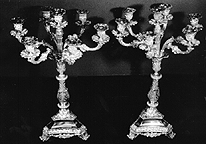![]()

The seven-branch menorah or candelabrum serves as a symbol of both ancient and modern Judaism. According to the Talmud, God gave Moses the design for the "candelabrum" and ordered him to include it among the vessels of the Tabernacle. During the First and Second Temple period, copies of this menorah were made and were placed around the sanctuary. According to the Priestly Code, the menorahs had to remain lit from dawn until dusk. Although this ritual was a religious requirement, it probably had a practical purpose as well. More specifically, if Jews (either individually or as a group) felt the need to go to the Temple at night, it was obviously necessary that the Temple remained illuminated. After the destruction of the Temple, it became forbidden (on the basis of Talmudic law) to reproduce the seven-branched menorah. Still, the image of the candelabrum often appeared on paintings and was engraved on religious articles. Today, the seven-branch menorah is the symbol of Israel. Except for in the Reform tradition, seven-branched menorahs are no longer placed in synagogues.
| Back to Treasures | Glossary | Jewish Holidays | Life Cycle | Home Page |